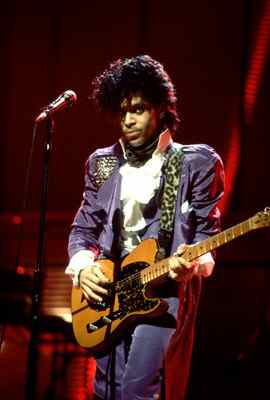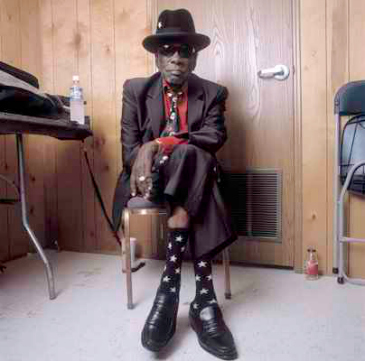Rock Photographer Paul Natkin Talks 'Superstars' Exhibit: The Days Of Full Access, Judas Priest And Big Macs With Motörhead
By Carrie McGath in Arts & Entertainment on May 31, 2015 4:00PM

Paul Natkin being interviewed at the Ed Paschke Art Center./ Photo by Vesna K. Stelcer
After shooting a tennis match in Evanston in 1976, Chicago photographer Paul Natkin got into his car and turned on the radio. The station said that a little-known Blues guitarist was going to be playing at a venue near where he was at that moment. A fan of the Blues and a tireless, passionate photographer, Natkin headed to the venue and was given full access to photograph that then-little-known artist, Bonnie Raitt.
"I go to the backstage door and the guard said, 'Oh, you're with the press, do anything you want, just don't get on stage.'" He wasn't with the press, but he was hooked after shooting that show.
That is precisely where the story of this famous rock photographer begins, which is encapsulated in a new gallery, Superstars, at the Ed Paschke Arts Center.
The exhibition showcases many of his portraits as well as his kinetic live concert photographs, including subjects such as Prince, Judas Priest and John Lee Hooker.
Natkin knew Ed Paschke and has kept in contact with his son and told us how honored he is to have his work in the same space as the late local artist. "I tried to honor Ed by putting together a cool show." And it is definitely cool, to say the least. The historical value of it is incredible and significant as well. The majority of these works are from 1994 or prior, the glory years of concert photography.

Installation View at the Ed Paschke Center./ Photo by Vesna K. Stelcer
The son of a sports photographer, Natkin's photography career started in the sports arena. After finding out the perks his dad was receiving to shoot these events, he became interested and eventually followed in his footsteps. After that Bonnie Raitt show, though, Natkin knew the arena where he belonged in the long-term was music arenas, and he has since become one of the most prolific and well-known concert photographers with his work gracing the covers of Creem, Spin, Hit Parader and countless others.
Sitting in the middle of Kuma's busy dining room where the blasting black metal infuses the atmosphere as much as the burgers do, we talked to Natkin about his career. It was a discussion about access that was peppered with great little anecdotes about many of the artists he has captured, which were numerous back in the day but in today's morphing industry are harder to come by. Sweet and unpretentious, Natkin talks about the music industry with the same bluntness he employs in advising young photographers who are aspiring to earn a living as he has, telling them it is nearly impossible these days and most of that, simply, is a lack of access.
The irony, he said, is that the photographers today typically have only three songs to shoot a show and are often made to stand far away or shoot from awkward spots in the venue while audience members with smartphones and iPads can shoot the show from start to finish. This three-song rule is relatively recent, so for the majority of Natkin's career he had the joy and fortune to photograph entire sets and the results of that are incredible. Bruce Springsteen basically started the change in access after a show at Madison Square Garden in the early 1980s, where incessant flashbulbs from the paparazzi distracted the musician during his set. By the next day's show, the three-song rule started and began to take root as a standard rule.

Prince./ Photo by Paul Natkin
Shows are fun to watch and to shoot for Natkin when they encompass what showbiz is all about, and acts like Liberace and Bette Midler are two he mentioned as great performers. "I like shooting anybody who jumps around a lot; people who put on a show. I don't even care if they're good bands, but if they do all kinds of stuff like jump into the audience or just interact, that's what I like to shoot." One of his favorite bands to shoot is The Rolling Stones who, he says, still put on great shows. "It's called showbiz for a reason," Natkins says. "If someone's paying $200 for a ticket, they aren't there just to hear 'Gimme Shelter,' they wanna see a show."
Since Natkin recently tallied 4,500-plus performers in his archives since the 1970s, he is now frequently asked for photos to include in box sets, such as Hall and Oates, since he has such complete and cohesive archive of so many of their shows over many years, which he fears will soon be a lost art. "I don't think anybody thinks to the future, that there is an historical component here," he says. Though some bands and venues still give him total access like The Rolling Stones, Dave Matthews Band and John Mayer as well as festivals such as Farm Aid and Chicago Blues Fest.

John Lee Hooker./ Photo by Paul Natkin
There are numerous backstage stories, but Natkin says it's not all that exciting. In Kuma's there is a print of his photograph of Motörhead. While Natkin was driving the band around before a photo shoot, Lemmy said he wanted to go to McDonald's and he captured a photo of the English rock band eating Big Macs. "And at one point, we're driving down Division Street and we pass a hot dog stand called Lemmy's and he made me stop and we took pictures in front of it." He continues with another story about having lunch with Judas Priest, telling us how normal the band was in that moment. "They showed up in golf sweaters and drank tea with their pinky fingers sticking out. But then they're totally nuts on stage."
See all of Paul Natkin's work at Superstars through June 14 at the Ed Paschke Art Center, 5415 W. Higgins Ave, across from the Jefferson Park Blue Line Stop. Admission is free.